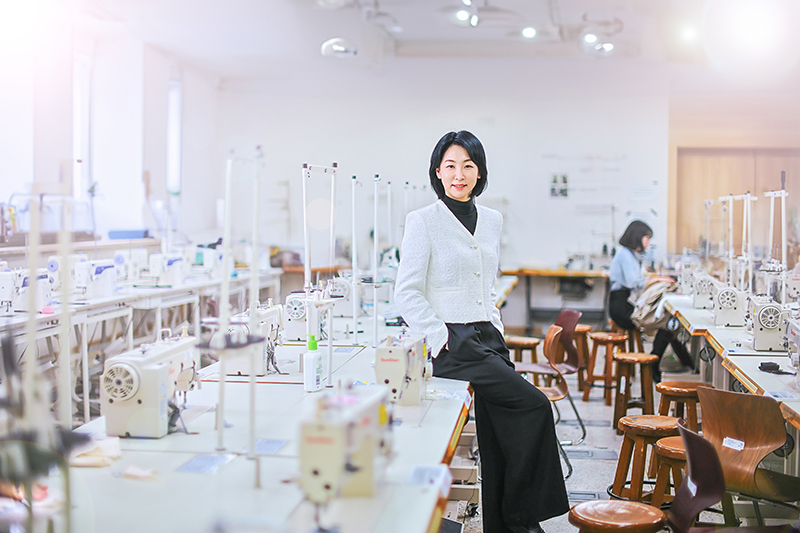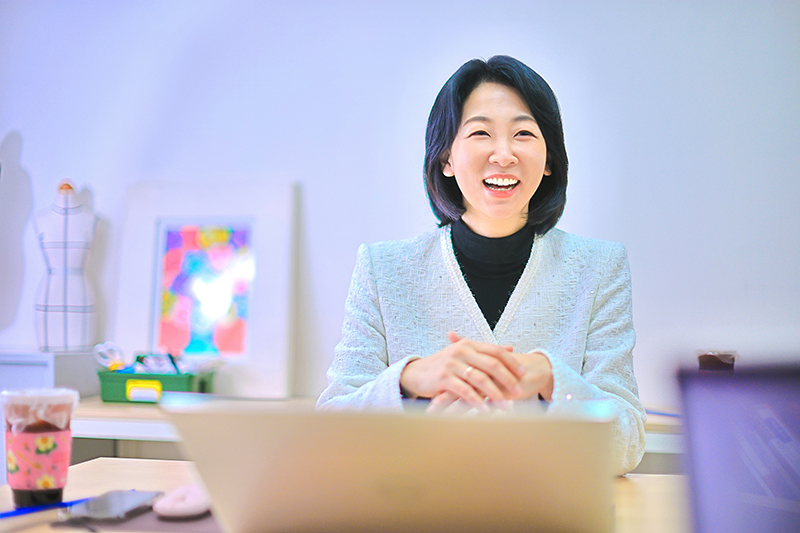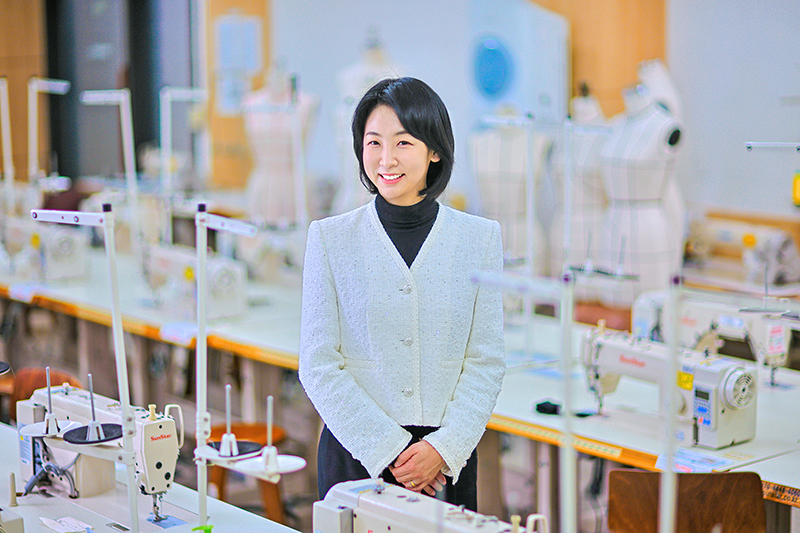header
Education News
“Patience, Empathy, and Genuineness: Fundamental Skillset for an Educator”
- WRITER 학무부총장실
- VIEW 94

Every year, the University celebrates exceptional faculty members in education and research by naming them Kyung Hee Fellows. In 2023, Professors Hwa Kyung Song at the Department of Clothing and Textiles and Kyung Hoon Han of the Department of Postmodern Music were selected as Kyung Hee Fellow in Education. We heard from Professor Song on her accomplishments and the guiding principles that shape her role as an educator
Professor Song, renowned for her stellar teaching evaluations, especially during the challenges posed by the pandemic, holds close to her heart such values as patience, empathy, and genuineness as the cornerstones of effective teaching. Throughout our conversation, her genuine commitment to her students and passion for both teaching and research shine through.
Even Amid the pandemic, Professor Song’s teaching evaluations saw a notable upsurge, particularly for her practical classes
Q. Congratulations on being recognized as a Kyung Hee Fellow in Education. What are your reflections on this accolade?
It was truly unexpected, yet it serves to remind me to redouble my efforts in my academic pursuits. This honor represents not only my individual achievements but also the collective dedication of educators striving for excellence in education. Looking ahead, I aim to chart a course that aligns with my values and positively impacts education and students learning. Even during moments of doubt, I am committed to making choices that I will not regret, always with the betterment of education and students in mind. I am grateful for the recognition and am energized to continue pushing boundaries in the future.
Q. Your courses focus on garment pattern design and production. Could you elaborate on these offerings?
My courses encompass both traditional garment production methods (Type 1) and modern techniques utilizing 3D virtual clothing design software (Type 2). Type 1 courses involve Pattern Design 1 and 2 or Tailoring, where students learn various aspects of garment creation, including flat pattern drafting, machine sewing, fitting adjustments, and garment finishing.
Type 2 courses, on the other hand, include Technical 3D Pattern Design and graduate-level seminars. In the preceding Type 1 process, we transitioned to using 3D virtual clothing design software (3D CLO). This allowed us to create garment patterns using CAD programs on 3D parametric avatars or real body scan avatars. Subsequently, we virtually stitched together the garments, a task previously conducted with sewing machines. Moreover, we could also execute forms akin to 3D fashion shows within the program.
Q. Your teaching evaluations experienced a significant surge even during the pandemic, particularly for practical courses. Can you shed light on your teaching strategies during this period?
I made a concerted effort to adapt and enhance my teaching methods amidst the challenges posed by the pandemic. For instance, the process of creating design blueprints has a step where lines are drawn with rulers. Initially, I condensed the paper flat design made in class. Subsequently, I digitized these designs, incorporating essential tools like curves and straightedges into photo files to align with the blueprint creation process. To emulate the classroom experience as closely as possible, I produced instrumental videos where students could see the blueprint lines and tools, akin to being present in class. We continue to effectively utilize these resources that were developed during that time. I also make a point of engaging with students seated at the back of the classroom by sharing teaching materials with them.
Furthermore, I proactively utilized e-campus platforms to tackle the challenges of in-person instruction. Each week, I established assignment repositories where students could submit photos of their design blueprints. I provided feedback promptly, marking areas for improvement and sharing insights with students through annotations. I provided timely feedback and support, even outside regular hours, to address students’ needs promptly. Pattern design is a process where a hiccup in one step can affect the subsequent steps. Therefore, I provided prompt feedback at each stage.
While the design process itself was efficient, I encountered some difficulties when it came to teaching the use of sewing machines. Students also needed explanations on the complex structure of these machines, prompting me to consider using augmented reality. Many research findings suggest that AR is effective for education, quality assurance, diagnostics, and training in industries like manufacturing, healthcare, and construction. Hence, I believed that integrating AR technology into garment construction could prove to be effective.

From technological innovation to pioneering education, developing AR-based content for garment construction and production
Q. Your pioneering use of augmented reality technology in education is commendable. Could you walk us through the implementation process?
Implementing augmented reality technology in education requires careful consideration. I identified various areas where AR could be applied, such as real-time remote communication during sewing machine operation, garment pattern design, and fitting checks converted into 3D garment forms. Given the lack of research in the field of apparel studies, I initiated two projects in 2022, which were selected for funding by the National Research Foundation of Korea (NRF). The projects included the development of an AR-based garment fit solution education system for Basic Research in Science & Engineering, and the development and application of AR-based garment construction education content for Humanities & Social Sciences. These projects marked pioneering efforts in the development of AR-based educational content in the domestic and international garment construction fields.
The outcomes of these projects continue to be utilized in lectures. To illustrate, I scanned and modeled industrial sewing machines, including lockstitch and overlock machines located in Room 306 of the College of Human Ecology, and integrated them into an AR platform to develop educational content on sewing machine operation. Students can view 3D sewing machines through AR devices such as Microsoft HoloLens or by using tablets or smartphones to scan QR codes. By clicking on the desired learning step, students receive step-by-step guidance. Additionally, they can align the actual sewing machine with the 3D model to verify correct threading and perform checks. The flexibility of learning from anywhere, not just in the classroom significantly enhanced education effectiveness and satisfaction.
In our undergraduate independent research, I utilized an AR remote communication platform to provide real-time feedback to students on pattern making and fitting processes. The advantage of being able to visually illustrate complex concepts in real-time using 3D images was invaluable. However, I acknowledge areas for improvement remain in AR technology application, and I plan to conduct further research to address these challenges.
Q. Your enthusiasm for education is evident in instances where you plan research to enhance the student approachability and access of lecture contents. Additionally, you've procured programs through participation in the University Innovation Support Project alongside your research planning efforts. Could you elaborate on this aspect?
In the wake of the pandemic, the digitalization of the garment production industry accelerated. Companies now commonly integrate 3D clothing design software into their fashion development and production processes, leveraging virtual clothing assets for e-commerce and virtual fashion presentations. While businesses swiftly adapt to these changes, universities face unique challenges. In 2019 and 2020, I procured six copies of the 3D design software program using my personal research funds, supplemented by two more through departmental budgets and support from NRF’s Leaders In Industry-University Cooperation (LINC) Office. However, having eight 3D design workstations still fell short of meeting all student needs.
From 2022 onwards, participation in NRF’s University Innovation Support Project enabled the acquisition of twelve additional 3D design workstations. This expansion allowed us to increase enrollment capacity of the Technical 3D Pattern Design course from 15 to 21 students. Subsequently, in 2023, department professors and I worked together to devise eight courses and two contests under the same initiative. This effort secured subscriptions for 20 copies of the program, facilitating an increase in enrollment capacity to 40 students. I believe that exposing students to 3D virtual clothing design software not only enhances their employability but also lays a strong groundwork for launching fashion brands utilizing digital technology.

In every choice lies a student-centric approach
Q. Your dedication to students shines through various activities. Could you elaborate on your approach to teaching?
Personally, I don’t consider myself naturally confident, and I’m well aware of areas where I can improve. Some students struggle to grasp concepts or repeatedly seek clarification. In response, I diligently revisit course materials, striving to enhance the clarity of my delivery. My academic journey wasn’t without challenges; I particularly struggled with sewing machines during my undergraduate years, an experience that informs my anticipation of the hurdles students may encounter in my classes. Empathy guides me as I meticulously structure course content to address potential difficulties.
Empathizing with students’ perspectives is paramount. I consciously strive to respond patiently, even to repeated inquiries. I’ve noticed that many students struggle with feelings of isolation and adversity. It seems that they appreciate my way of treating them with kindness. Personally, becoming a parent has changed how I approach teaching. I consider my students as part of my extended family and approach them as I would want my own children to be treated in the future. Interacting with students and realizing that I can positively impact their lives has deepened my passion for my profession.
Reflecting on my undergraduate years, I initially believed I lacked talent in fashion design and struggled in that realm. Yet, my strengths lie in mathematical domains rather than in the traditional design fields. This realization led me to specialize in garment construction within the broader fashion design discipline. Through dedicated study at institutions such as the Fashion Institute of Technology (FIT) in New York and later, Cornell University, where I earned my PhD, I unexpectedly gained confidence. My mentors didn’t just impart knowledge; they fostered a collaborative learning environment, encouraging independent problem-solving with insightful guidance.
Q. Your selection as a Kyung Hee Fellow in Education suggests a strong emphasis on communication with students. Do you have any specific strategies for fostering communication with your students?
Some argue that teaching today’s students is challenging, but I haven’t noticed significant differences compared to previous generations. Especially undergraduate students, who arrive at university immediately after graduating from high school, are in a state of pure enthusiasm. I strive to respect students for who they are and guide them in the right direction, even as they navigate through their immaturity. It’s my perspective that has evolved, not the students’ identities.
There have been moments when supporting students has been mutually beneficial. During counseling sessions, I encountered students grappling with personal issues, a struggle I could empathize with as I was facing similar challenges myself. Witnessing students in such difficult situations prompted me to address my own vulnerabilities and offer them the best support I could. Fortunately, many of them showed remarkable improvement. These experiences underscored my significance in students’ lives and facilitated my own positive growth. Lately, there seems to be a rise in students experiencing depression, and if I can provide solace and support, I am eager to help. Such opportunities, I believe, are the true rewards of being an educator.
Q. It seems like these moments transcend being just a teacher and evolve into opportunities to become a mentor. Do you have any aspirations for the future?
Receiving the Kyung Hee Fellow in Education has revitalized me, despite feeling somewhat fatigued recently. My goal is to educate without any sense of personal embarrassment. I aim to maintain a positive demeanor as an educator, continuing to treat students with the same care and respect I have always upheld. Additionally, I aspire to persist in researching and implementing new advancements without succumbing to complacency. With retirement still approximately two decades away, I am dedicated to remaining proactive and ensuring that I seize beneficial opportunities rather than yielding to any sense of inertia.
